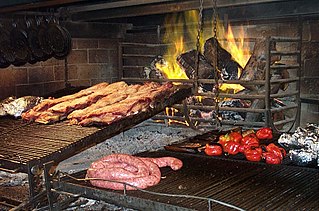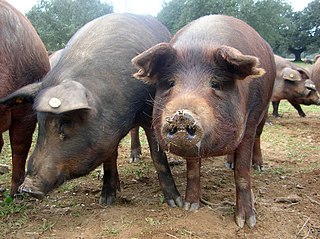
Argentine cuisine is described as a blending of cultures, from the Indigenous peoples of Argentina who focused on ingredients such as humita, potatoes, cassava, peppers, tomatoes, beans, and yerba mate, to Mediterranean influences brought by the Spanish during the colonial period. This led to cultural blending of criollos, Indigenous, and sub-Saharan African in the cuisine. Later, this was complemented by the significant influx of Italian and Spanish immigrants to Argentina during the 19th and 20th centuries, who incorporated plenty of their food customs and dishes such as pizzas, pasta and Spanish tortillas.

Spanish cuisine consists of the traditions and practices of Spanish cooking. It features considerable regional diversity, with important differences between the traditions of each of Spain's regional cuisines.

A sausage is a type of meat product usually made from ground meat—often pork, beef, or poultry—along with salt, spices and other flavourings. Other ingredients, such as grains or breadcrumbs may be included as fillers or extenders.

Valladolid is a province of northwest Spain, in the central part of the autonomous community of Castile and León. It has a population of 520,716 people in a total of 225 municipalities, an area of 8,110 km2 (3,130 sq mi) and a population density of 64.19 people per km2.

A blood sausage is a sausage filled with blood that is cooked or dried and mixed with a filler until it is thick enough to solidify when cooled. Most commonly, the blood of pigs, sheep, lamb, cow, chicken, or goose is used.

Chorizo is a type of pork sausage originating from the Iberian Peninsula. It is made in many national and regional varieties in several countries on different continents. Some of these varieties are quite different from each other, occasionally leading to confusion or disagreements over the names and identities of the products in question.

Asado is the technique and the social event of having or attending a barbecue in various South American countries: especially Argentina, Chile, Paraguay, Peru, and Uruguay where it is also a traditional event. An asado usually consists of beef, pork, chicken, chorizo, and morcilla; all of which are cooked using an open fire or a grill, called a parrilla. Usually, red wine and side dishes such as salads accompany the main meats, which are prepared by a designated cook called the asador or parrillero.

Salvadoran cuisine is a style of cooking derived from the nation of El Salvador. The indigenous foods consist of a mix of Amerindian cuisine from groups such as the Lenca, Pipil, Maya Poqomam, Maya Chʼortiʼ, Alaguilac and Cacaopera peoples. Many of the dishes are made with maize (corn). There is also heavy use of pork and seafood. European ingredients were incorporated after the Spanish conquest.

Ribera del Duero is a Spanish Denominación de Origen Protegida (DOP) located in the country's northern plateau and is one of eleven 'quality wine' regions within the autonomous community of Castile and León. It is also one of several recognised wine-producing regions to be found along the course of the Duero river.

Castilian-Leonese cuisine refers to the typical dishes and ingredients of the region of Castile and León in Spain. This cuisine is known for its cooked dishes (guiso) and its grilled or roasted meats (asado), its high-quality wines, the variety of its desserts, its sausages (embutidos), and its cheeses.

Balearic cuisine is a Mediterranean cuisine as cooked in the Balearic Islands, Spain. It can be regarded as part of a wider Catalan cuisine, since it shares many dishes and ingredients with Catalonia and the Valencian Community. Others view it as part of a more global Spanish cuisine. Traditional Balearic cuisine is rich in vegetables, cereal and legumes as well as being low in fats. A succinct selection of the primary dishes would be ensaimades, seafood and vegetable stews, sobrassada, coques, tombet, Maó cheese and wine.

Uruguayan cuisine is a fusion of cuisines from several European countries, especially of Mediterranean foods from Spain, Italy, Portugal and France. Other influences on the cuisine resulted from immigration from countries such as Germany and Scotland. Uruguayan gastronomy is a result of immigration, rather than local Amerindian cuisine, because of late-19th and early 20th century immigration waves of, mostly, Italians. Spanish influences are abundant: desserts like churros, flan, ensaimadas yoo (Catalan sweet bread), and alfajores were all brought from Spain. There are also all kinds of stews known as guisos or estofados, arroces, and fabada. All of the guisos and traditional pucheros (stews) are also of Spanish origin. Uruguayan preparations of fish, such as dried salt cod (bacalao), calamari, and octopus, originate from the Basque and Galician regions, and also Portugal. Due to its strong Italian tradition, all of the famous Italian pasta dishes are present in Uruguay including ravioli, lasagne, tortellini, fettuccine, and the traditional gnocchi. Although the pasta can be served with many sauces, there is one special sauce that was created by Uruguayans. Caruso sauce is a pasta sauce made from double cream, meat, onions, ham and mushrooms. It is very popular with sorrentinos and agnolotti. Additionally, there is Germanic influence in Uruguayan cuisine as well, particularly in sweet dishes. The pastries known as bizcochos are Germanic in origin: croissants, known as medialunas, are the most popular of these, and can be found in two varieties: butter- and lard-based. Also German in origin are the Berlinese known as bolas de fraile, and the rolls called piononos. The facturas were re-christened with local names given the difficult German phonology, and usually Uruguayanized by the addition of a dulce de leche filling. Even dishes like chucrut (sauerkraut) have also made it into mainstream Uruguayan dishes.

Chilean cuisine stems mainly from the combination of traditional Spanish cuisine, Chilean Mapuche culture and local ingredients, with later important influences from other European cuisines, particularly from Germany, the United Kingdom and France. The food tradition and recipes in Chile are notable for the variety of flavours and ingredients, with the country's diverse geography and climate hosting a wide range of agricultural produce, fruits and vegetables. The long coastline and the peoples' relationship with the Pacific Ocean add an immense array of seafood to Chilean cuisine, with the country's waters home to unique species of fish, molluscs, crustaceans and algae, thanks to the oxygen-rich water carried in by the Humboldt Current. Chile is also one of the world's largest producers of wine and many Chilean recipes are enhanced and accompanied by local wines. The confection dulce de leche was invented in Chile and is one of the country's most notable contributions to world cuisine.

Curiel de Duero is a municipality located in the province of Valladolid, Castile and León, Spain. It covers an area of 18,75 km2, has a population of 134 inhabitants, yielding a density of 6,93 inhabitants/km2. It belongs to the Valle del Cuco and the county of Campo de Peñafiel. The municipalities of San Llorente, Corrales de Duero, Valdearcos de la Vega, and Bocos de Duero also belong to the Valle del Cuco. Roturas, that borders north to Curiel De Duero, historically also belonged to Curiel, but has in modern times not been included into the Valle del Cuco county. In 1900, Curiel had its peak of 590 inhabitants.

Extremadura, Spain is known for its different ways of preparing the Iberian pork and mutton. The main characteristics of the traditional Extremaduran cuisine are its simplicity, its lack of clutter and its low cost. It is also a cuisine reflecting a generous spirit, for many of its preparations used to be cooked in large pots to share with visitors, friends, and neighbors. The resulting dishes are eaten with local bread.

Paraguayan cuisine is the set of dishes and culinary techniques of Paraguay. It has a marked influence of the Guaraní people combined with the Spanish cuisine and other marked influences coming from the immigration received by bordering countries such as Italian cuisine and German cuisine. The city of Asunción is the epicenter of the distinctive gastronomy that extends in current Paraguay and its areas of influence, which is the reason why is considered the mother of the gastronomy of the Río de la Plata. It is worth clarifying that in the Paraguayan society, the exchange of knowledge between mestizos, creoles and cario-guaraní people occurred before the Jesuit missions.





![Queso pata de mulo [es] (Cheese mule leg). Queso pata de mulo 05.jpg](http://upload.wikimedia.org/wikipedia/commons/thumb/4/41/Queso_pata_de_mulo_05.jpg/220px-Queso_pata_de_mulo_05.jpg)

































